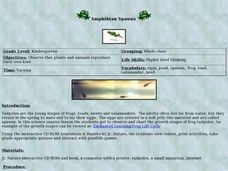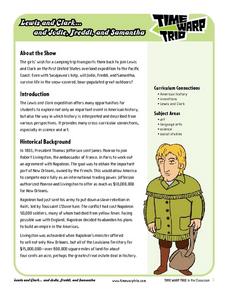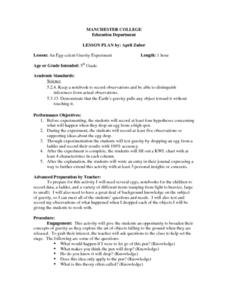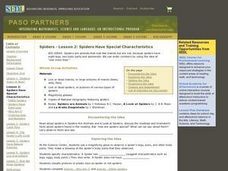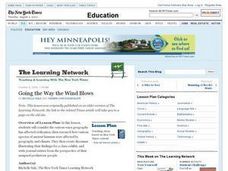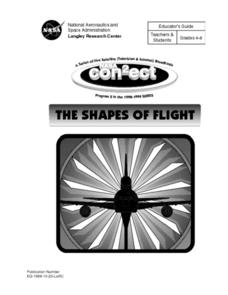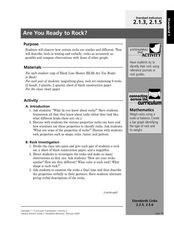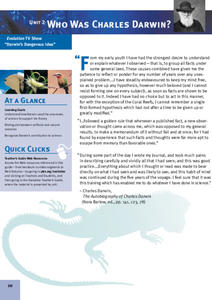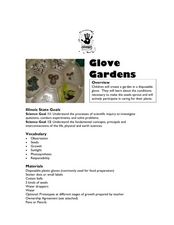Curated OER
Amphibian Spawns
Students observe tadpoles as they gradually change into adults. In this amphibian biology lesson plan, students watch tadpoles in a tank in the classroom, keep a daily record of what they observe, and chart the growth development...
Curated OER
Investigating Local Ecosystems
Learners observe a local area for living organisms and their habitats. In this local ecosystems lesson, students complete an online field journal. Learners share their findings and sort them into categories. Students visit a...
Curated OER
Lewis and clark...and Jodie, Freddi, and Samantha
Students practice descriptive language when one student describes an object to another student who cannot see it. They guess what the object is and relate the experience to that of the Lewis and Clark expeditionary journals.
Curated OER
An Egg-celent Gravity Experiment
Fifth graders record at least four hypotheses concerning what happens when they drop an egg from a high spot. They record at least five observations or supporting ideas about the egg drop. Students test gravity by dropping an egg from a...
Curated OER
Identifying Erosion
Students identify erosion in various forms and explain its causes. They look for evidence of erosion on school grounds, describe it in their journals, and draw labeled rough sketches of the erosion.
Curated OER
Chicago: The City in Art, 1995-2000
Students examine a mural of animals and talk about animal classification. They act as scientists and keep a record, called a Jungle Journal, of plants and animals they observe while studying the rainforest.
Curated OER
Spiders Have Special Characteristics
Students state reasons why spiders are grouped in specific categories, including what distinguishes a spider from an insect. They report on their observations of the spiders. They illustrate their report with drawings in their journals.
Curated OER
How Does Your Garden Grow?
Learners read The Garden by Arnold Lobel, plant seeds to discover what makes them grow, and record their observations in their journals.
Curated OER
Going the Way the Wind Blows
Students examine the cause and effect relationship between geography and ancient civilizations. After reading an article, they determine how new findings can help scientists examine the migration patterns of these civilizations. Using...
Curated OER
Phases of the Moon
Students answer the question, "How are the motions of the Earth, the moon, and the sun, related to the moon's phases?" They observe the moon to create a moon journal and a phases of the moon diagram.
Curated OER
What's in a Garden?
Students explore the concept of philanthropy. In this service learning lesson, students plan a garden. Students write a paragraph in their journals giving their recommendation on how their garden should be laid out.
Curated OER
When Dinosaurs Ruled The World
Students discover how a paleontologist digs up fossils and what tools they use. In this paleontology lesson, students discuss the importance of the job of a paleontologist, watch a video on the process of extracting fossils, and...
Curated OER
Flights of Fancy?
Students reflect on the dynamics of human flight and how objects fall through the air and how science principles are used in flight.
They create a How-It-Works poster diagramming the science behind one method of flying. In addition,...
Curated OER
Jack and the Beanstalk
Third graders read a story and grow a beanstalk. In this literature and life science lesson, the class reads "Jack and the Beanstalk," then lists fairy tale elements and write a puppet show. The students plant pinto beans and observes...
Curated OER
The Shapes of Flight
Students explore interaction between mathematics, science, and technology as they look at process of researching, developing, testing, and evaluating airplane design. They calculate glide ratio for model paper airplane by using data...
Curated OER
Are You Ready to Rock?
Second graders investigate rock samples using magnifying class. In this earth science lesson, 2nd graders identify the physical properties and describe them verbally with their partners. They compare their findings with the class.
Curated OER
Who Was Charles Darwin?
Students examine how Darwin used the processes of science to support his theory. They distinguish between artificial and natural selection, recognize Darwin's contribution to science. They produce a newspaper describing the times in...
Curated OER
Environment: The River Classroom
Seventh graders engage in hands-on experiments and activities dealing with rivers and greenways. They also observe lectures and demonstrations by experts in water and river restoration. Students and teachers participate in canoe trips...
Curated OER
Glove Gardens
Students investigate how seeds sprout. In this scientific inquiry instructional activity, students make predictions on which seeds will grow the fastest and observe the seeds over a period of time. Observations are recorded into a...
Alabama Learning Exchange
A Rockin' Investigation
Young scientists identify the rock cycle. In this earth science activity, students participate in web-based research to understand how sedimentary, metamorphic, and igneous rocks form. As a follow-up, they collect various rocks and...
Curated OER
The Earth is Flat
Third graders experiment to gain understanding of the shape and rotation of the Earth. In this Sun and Moon science instructional activity, 3rd graders understand that the Earth rotates on its axis and how that explains the appearance...
Curated OER
"You may now enter the Holodeck."
Young scholars study and make a hologram. In this holography mini-unit, students study the science behind holography and in the culminating activity they create their own holograph. This mini-unit includes six lessons and a culminating...
Curated OER
Cooking Up the Scientific Method
First graders identify the different steps of the scientific method. For this life science lesson, 1st graders apply this method when conducting a series of hands-on activities. They collect data and write observations in their journals.
Curated OER
Paper Airplane Contest
Students research principles of flight. They design their own paper airplanes and make predictions about the performance of different designs. Students keep track of their findings in an electronic journal.
Other popular searches
- Elementary Science Journals
- Science Journals Set Up
- Making Science Journals
- Science Journals Rocks
- Space Science Journals
- Creating Science Journals
- Science Journals Trees
- Reasons for Science Journals
